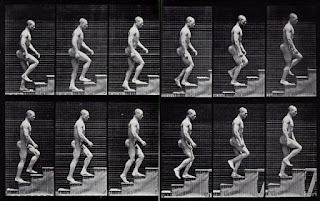How to Use 3-Act Story Structure in Comic Strips
by Tim Stout
https://timstout.wordpress.com/2011/09/03/how-to-use-3-act-story-structure-in-comic-strips/
In just three to four comic panels, you can utilize three-act structure to tell a story. If there’s conflict and a character reacting to that conflict then you’ve got a story and that can easily fit within three or four comic panels.Here’s the breakdown I used to discuss three-act story structure in the lecture:
 Act 1 is the “Beginning”, where information is setup to provide CONTEXT for the story.
Act 1 is the “Beginning”, where information is setup to provide CONTEXT for the story.Act 2 is the “Middle”, where characters attempt to achieve GOALS and encounter CONFLICT.
Act 3 is the “End”, where there is a RESOLUTION to the CONFLICT and our character’s character is revealed.
Panel 1 (yellow) is Act 1. It provides the CONTEXT for the strip, answering the 5W’s: Where, When, Who, What and Why.
 In this example (Calvin & Hobbes by Bill Watterson), the CONTEXT (5W’s) for the strip is:
In this example (Calvin & Hobbes by Bill Watterson), the CONTEXT (5W’s) for the strip is:- Where are we? A white space. We may be inside or we may be outside, it doesn’t matter. The rest of the strip should make sense without that information. (If it doesn’t make sense, then Bill should have clarified).
- When are we? Day or night is not specified, so it shouldn’t matter for the rest of the strip to make sense. (But it is set post-1932. How do we know that? The character is playing Superman, who was created in 1932.)
- Who is involved? A kid. We know his name is Calvin from the title of the strip, Calvin & Hobbes, but within the CONTEXT of Panel 1, it doesn’t matter. All we really need to know is that the character is a kid who plays pretend.
- What are they doing (their GOAL)? Playing Superman. And we know that by the use of Superman’s trademark line “Up, up and away!” along with the cape.
- & Why are they doing that? Probably because playing Superman is fun.
Panel 2 (blue) shows the character trying to achieve their GOAL – the WHAT from Panel 1 put into action. It can also be called the PREMISE of the strip.
Using the same example, Calvin’s GOAL is to play Superman, so in Panel 2 we get to see Calvin doing just that: playing Superman.
 But
there is no story without a problem. So, there must be CONFLICT.
Something (a person, a thing, fate, or a force of nature) must CONFLICT
with the character’s GOAL.
But
there is no story without a problem. So, there must be CONFLICT.
Something (a person, a thing, fate, or a force of nature) must CONFLICT
with the character’s GOAL.This CONFLICT brings the potential DEATH OF THE PREMISE.
 In Panel 3 (red), gravity prevents Calvin from flying (CONFLICT). Will this be the DEATH of playing Superman?!
In Panel 3 (red), gravity prevents Calvin from flying (CONFLICT). Will this be the DEATH of playing Superman?! NO! Calvin continues to play Superman despite the reality of his situation, thus revealing something about his character.
NO! Calvin continues to play Superman despite the reality of his situation, thus revealing something about his character.Character is revealed through conflict and Panel 4 (green) is where we get to see that.
Panel 4 is the RESOLUTION of the CONFLICT, and that RESOLUTION lets the reader know something about your character.
This is where you get to show how your character behaves or thinks. In a well-written comic strip, it results in something funny or unexpected.
Calvin has every reason to give up pretending to be Superman but he refuses and improvs his way back into play. Why? Because play is more fun than reality (and if you’ve read Calvin & Hobbes, you’ll know just how true that is for Calvin).
Here’s another Calvin & Hobbes example:
 Panel 1 [Act 1] – CONTEXT (5W’s):
Panel 1 [Act 1] – CONTEXT (5W’s):- Where are we? A white space.
- When are we? Day or night is not specified, but it is set after those bubble bottles were created and mass-marketed for kids.
- Who is involved? Calvin.
- What are they doing (their GOAL)? Blowing a bubble.
- & Why are they doing that? Blowing bubbles is fun?
Panel 3 [Act 2.2] – CONFLICT (DEATH OF THE PREMISE): Calvin is stopped in blowing a bubble. Is this the DEATH of blowing bubbles?
Panel 4 [Act 3] – RESOLUTION: Yes. Calvin’s reaction to what happened reveals his character.
THE END!
The best part about Panel 4 is that different characters can provide a totally different outcome or joke from the same PREMISE.
Here’s an example of a Nancy strip by Ernie Bushmiller (notice how Nancy’s reaction to the DEATH OF THE PREMISE provides an entirely different joke):
 Panel 1 [Act 1 and 2.1] – CONTEXT (5W’s) & GOAL:
Panel 1 [Act 1 and 2.1] – CONTEXT (5W’s) & GOAL:- Where are we? Outside a store.
- When are we? Daytime.
- Who is involved? Nancy.
- What are they doing (their GOAL)? Blowing a bubble.
- & Why are they doing that? Blowing bubbles is fun?
- GOAL (WHAT in action. The PREMISE): Nancy blows a bubble.
Panel 3 [Act 3] – RESOLUTION: Yes. Nancy’s reaction to what happened reveals her character.
THE END!
So, when writing your own comic strips, keep this breakdown in mind and use Panel 4 to show the reader what makes your character interesting, funny or unique.
I hope that helps!




